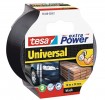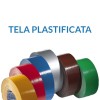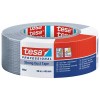What is duct tape? Special features and characteristics
What is cloth tape? Indeed, this term could raise some questions in people who have never had anything to do with the so-called duct tape, and who instead have only used other types of adhesive tape in their life.
For example, regular office tape, typically placed inside special dispensers, with a rather low adhesive power. Or, perhaps masking paper tape, used when painting the house, or for industrial painting.
Or, insulating tape, a precious ally for all electricians. Then, there is double-sided tape to consider, in all its forms, from the stationery-like kind to the most powerful rolls, used to lay carpeting and rugs in stable positions.
And then, there is the American duct tape, which stands out for its versatility among all kinds of tape on the market. Of course, it is not transparent, it is not industrial double-sided adhesive, and it is not even insulating, meant for work with electrical devices.
Nevertheless, duct tape can be useful in different situations, for miscellaneous makeshift repairs. So, let’s have a look at what “duct tape” means, and what the main features of this precious tool are!
Defining duct tape
So, let’s have a look at what duct tape is.
If we were to look for this term in some kind of technical glossary, we might find this definition: it is a type of adhesive tape which can be put in place by pressure, characterized by a peculiar internal support cloth structure ensuring greater strength, as well as a polyethylene coating which guarantees a good degree of waterproofing.
The one above is a short but complete definition of American duct tape. It should be noted that there are several other special features of this adhesive tool which are worth knowing, but for now it is enough to be able to identify, among all others, this very useful tool.
But how did the development of such a robust and original kind of tape come about?
The invention of American tape
Let’s quickly outline the story of duct tape.
It is necessary to start from a premise: “normal” adhesive tape, the one used for masking work – developed in the Twenties – then slowly spread to other areas of use.
There was, however, no adhesive tape meant for makeshift repairs, durable and practical which could be used in any situation. The person who noticed this deficiency more than anyone else was, apparently, an American worker, Vesta Stoudt.
The year is 1943, in the middle of a World War, and Vesta is thinking about her two sons, enlisted in the United States Navy; for this reason, she writes a letter to the office of President Franklin Delano Roosevelt, proposing the creation of a cloth tape capable of easily sealing ammunition crates.
It was this idea that led the War Production Board to start to work on the development of a tool which could combine the characteristics of the best adhesive tape available at the time with those of the so-called “duck cloth”, i.e., double-sided fabric tape which was, at the time, used for makeshift repairs in the most diverse sectors.
Within a few months, American cloth tape became a reality, and was used by the Army to seal ammunition crates, but also to restore equipment and weapons to a battlefield-worthy status.
The first models, needless to say, were made with camouflage colours, chief among them the olive shades. At the end of the Second World War, while remaining in the army’s standard equipment, cloth tape began to take root in the civilian world as well, through US hardware stores.
The characteristics of duct tape
To understand what it means to use duct tape, of course, the best course of action is buying a roll and using it. It is an extremely resistant industrial double-sided tape, which can be subjected to strong traction – for example during the sealing of very heavy boxes, as well as pipes and so on – without it tearing.
Though it presents such great resistance, the tape can be cut without using scissors or cutters: using both hands is enough to be able to cut a piece of tape of the desired length, with the certainty of having a clean and perfectly perpendicular cut, because of the texture of the cloth presents inside the tape itself.
But that’s not all: it is not just the level of resistance to be high, but the level of adhesiveness as well, which allows for the use of adhesive cloth tape not only on perfectly smooth surfaces such as steel, but on less homogeneous surfaces, such as wood, plaster, or cement as well.
As previously mentioned, moreover, American strong double-sided adhesive tape is characterized by a polyethylene outer coating, to gains different colours but above all to have a good level of water resistance, to be used outdoors without issues as well.







